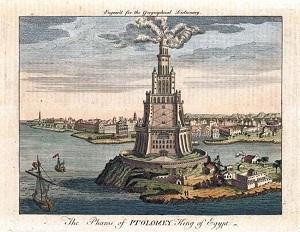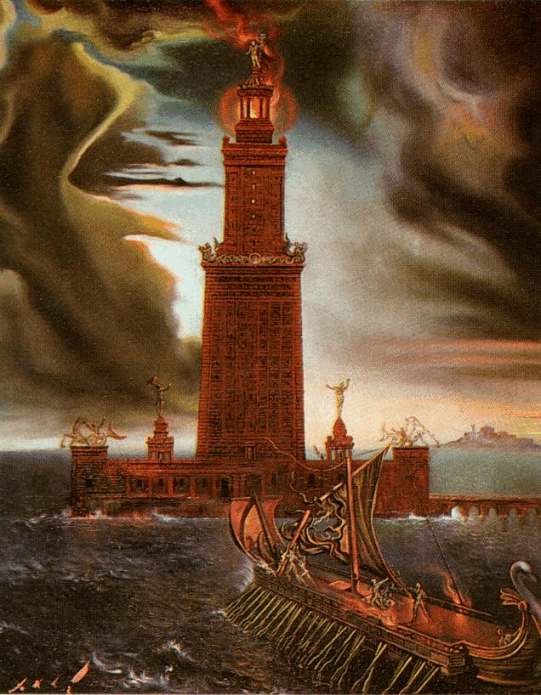The Lost Lighthouse of Alexandria: A Mystery of the Ancient World

Have you ever wondered about the mysteries of the ancient world? The Lost Lighthouse of Alexandria is one such enigma that continues to captivate historians and archaeologists. This magnificent structure, also known as the Pharos of Alexandria, was a beacon of light and a symbol of technological advancement during its time.
Introduction to the Lost Lighthouse of Alexandria and its historical significance
The Lost Lighthouse of Alexandria was built in the 3rd century BC on the island of Pharos in Alexandria, Egypt. Standing at an impressive height of over 100 meters (330 feet), it was one of the tallest man-made structures in the world at that time. Its primary purpose was to guide ships safely into the harbour by emitting a powerful beam of light.
This architectural marvel was commissioned by Ptolemy I, one of Alexander, the Great's generals, and designed by Sostratus of Cnidus. The lighthouse was constructed using large blocks of white marble, making it a striking landmark visible from miles away.
The Lost Lighthouse of Alexandria served as a functional navigational aid and showcased the ancient city's engineering prowess and wealth. It featured three levels: a square base, a middle octagonal section, and a cylindrical top housing the fire that produced the light. The light source remained a mystery for centuries, with some theories suggesting it was fueled by burning oil or a large mirror reflecting sunlight.
Sadly, this iconic structure met its demise during earthquakes in the 14th century AD. Today, all that remains are ruins submerged beneath the Mediterranean Sea.
The Lost Lighthouse of Alexandria intrigues historians and archaeologists alike, as its location and architectural details remain unknown. Despite its disappearance, its legacy is a testament to ancient engineering and the quest for knowledge in the ancient world.
:max_bytes(150000):strip_icc()/lighthousealexandria-58b9e0143df78c353c4d48a4.jpg)
The Construction of the Lighthouse
The design and construction of the Lighthouse of Alexandria
Imagine yourself transported back in time to the ancient city of Alexandria, Egypt. As you stroll along the bustling streets, you glimpse a magnificent structure rising above the cityscape - the Lighthouse of Alexandria.
Built during the reign of Ptolemy I Soter in the 3rd century BC, this architectural marvel was one of the Seven Wonders of the Ancient World. Its purpose was to guide ships safely into the harbour, and it stood as a symbol of Alexandria's power and wealth.
The design and construction of the Lighthouse were truly remarkable for its time. The structure stood at an impressive height of approximately 330 feet, making it one of the tallest man-made structures in the world at that time. It consisted of three levels - a square base, a middle octagonal section, and a circular top - all made from white marble.
At the top of the Lighthouse, a large mirror reflected sunlight during the day, while a fire burned brightly at night. This combination provided a powerful beacon that could be seen from miles away, guiding ships safely to shore.
To construct such a monumental structure, engineers faced numerous challenges. The foundation had to be strong enough to support the weight of the Lighthouse and withstand the powerful waves crashing against it. They used large stones and concrete to create a solid base to withstand these forces.
The Lighthouse's construction was a testament to ancient engineering prowess and innovation. Its design incorporated elements from various architectural styles, including Greek and Egyptian influences. The result was a masterpiece that stood for centuries until earthquakes eventually destroyed it in the 14th century AD.
Today, all that remains of this once-mighty structure are ruins beneath Alexandria's waters. The mystery surrounding its exact location and the secrets it holds continue to captivate historians and archaeologists alike, making the Lighthouse of Alexandria a true enigma of the ancient world.

The Function and Importance of the Lighthouse
The role of the Lighthouse in ancient Alexandria and its importance for navigation
Imagine yourself sailing through the ancient waters of Alexandria, relying on the guidance of a magnificent structure that stood tall and proud - the legendary Lighthouse of Alexandria. This architectural wonder was a symbol of grandeur and played a crucial role in ensuring safe navigation for sailors.
Built during the reign of Ptolemy II in the 3rd century BC, the Lighthouse was one of the Seven Wonders of the Ancient World. Standing at an impressive height of over 100 meters, it served as a beacon of light for ships approaching the harbour.
In those times, navigation was a challenging task. Sailors had to rely on the stars, landmarks, and coastal fires to find their way. The Lighthouse revolutionized this process by providing a reliable and visible landmark that guided ships safely into port.
The Lighthouse's importance cannot be overstated. It facilitated trade and commerce and ensured the safety of sailors and their valuable cargo. Ships from all over the Mediterranean would navigate towards Alexandria, knowing that they could trust this magnificent structure's guidance.
Unfortunately, despite its historical significance, the Lighthouse of Alexandria no longer stands today. Its exact fate remains a mystery, with various theories suggesting earthquakes, erosion, or sabotage as possible causes for its demise.
Nevertheless, the legacy of this ancient marvel lives on. It serves as a reminder of human ingenuity and the importance of landmarks in navigation. Even in modern times, lighthouses remain vital in guiding ships safely through treacherous waters.
So next time you find yourself near a lighthouse or hear tales of ancient wonders like the Lighthouse of Alexandria, take a moment to appreciate their significance. These structures illuminate our past and remind us of the importance of navigation and the wonders of the ancient world.

The Mysterious Disappearance
Imagine standing on the shores of ancient Alexandria, gazing out at the majestic Lighthouse that once stood tall and proud, guiding ships safely to the harbour. Now, picture that same Lighthouse vanishing into thin air, leaving behind only a mystery that has puzzled historians for centuries.
Theories and speculations surrounding the disappearance of the Lighthouse
-
Natural Disasters: One theory suggests that a powerful earthquake or a tsunami may have destroyed the Lighthouse. Alexandria was located in a region prone to seismic activity, and such natural disasters could have caused the structure to crumble.
-
War and Invasion: Another possibility is that the Lighthouse fell victim to war and invasion. Throughout its history, Alexandria faced numerous conflicts, including attacks by Roman armies and later by Arab conquerors. It is plausible that these military campaigns destroyed the iconic landmark.
-
Gradual Decay: The Lighthouse may have deteriorated over time due to neglect and lack of maintenance. Even the most magnificent structures can succumb to the elements without proper care and slowly crumble away.
-
Purposeful Demolition: Some historians speculate that the Lighthouse was intentionally demolished for strategic reasons. As technology advanced, ships no longer relied solely on visual aids like lighthouses for navigation. Destroying the Lighthouse could have been a tactical decision to remove a potential landmark for enemy ships.
-
Lost to Time: Lastly, the true fate of the Lighthouse may have been lost to time. The ancient world was filled with countless wonders that have been forgotten or destroyed over centuries. The disappearance of the Lighthouse may be one of those lost mysteries.
Although the exact cause of the Lighthouse's disappearance remains unknown, its legacy lives on in the imaginations of those who marvel at the wonders of the ancient world. The mystery surrounding its fate only adds to the allure and intrigue of this once-great beacon of light.

Rediscovery Efforts
If you are a history enthusiast or an adventurer, you must have heard of the legendary Lighthouse of Alexandria. This ancient wonder was one of the Seven Wonders of the Ancient World, symbolising engineering excellence and architectural marvel. However, this magnificent structure was lost to history, leaving a captivating mystery behind.
Efforts were made to locate and rediscover the remains of the Lighthouse
Historians, archaeologists, and explorers have been captivated by the mystery surrounding the lost Lighthouse of Alexandria for centuries. Numerous efforts have been made to locate and rediscover its remains, but the exact location remains elusive. Here are some notable attempts:
-
Underwater Excavations: Given that the lighthouse was built on Pharos island, many believe its remains lie underwater. Several underwater excavations have taken place near the island in hopes of finding traces of this ancient wonder. However, due to centuries of natural disasters and human activities, locating the exact site has proven challenging.
-
Remote Sensing Techniques: In recent years, advanced remote sensing techniques such as sonar and satellite imaging have been employed to survey the area around Pharos Island. These technologies help researchers identify potential structures or anomalies beneath the water's surface that could be remnants of the lost lighthouse.
-
Historical Records: Scholars and historians have extensively studied ancient texts and historical records to gather clues about the lighthouse's location. These records provide valuable insights into its construction and dimensions, but pinpointing its exact whereabouts remains a puzzle.
Despite these efforts, the lost Lighthouse of Alexandria remains hidden, adding to its allure and mystique. The quest to rediscover this ancient wonder is ongoing. With advancements in technology and archaeological techniques, there is hope that one day its remains will be found, allowing us to unravel the secrets of this extraordinary structure.

Historical Accounts and Descriptions
Accounts from ancient historians and travellers about the Lighthouse's grandeur
Imagine yourself transported back in time to the ancient city of Alexandria, Egypt. As you stroll along the bustling streets, you are drawn to a magnificent structure rising above the cityscape - the legendary Lighthouse of Alexandria. This architectural marvel, also known as the Pharos of Alexandria, was one of the Seven Wonders of the Ancient World. Its grandeur and mysterious fate have captivated historians and travellers for centuries.
According to ancient historians and travellers, the Lighthouse stood approximately 120 meters (394 feet) high, making it one of the tallest man-made structures of its time. Its construction was commissioned by Ptolemy I Soter, a general under Alexander the Great, in the 3rd century BC. The purpose of the Lighthouse was to guide ships safely into the harbour of Alexandria.
Historians such as Strabo and Pliny the Elder described the Lighthouse as a magnificent structure adorned with white marble and intricate carvings. It was said to have been built in three tiers, with a massive mirror at its peak that reflected sunlight during the day and a fire at night to guide ships.
However, despite its grandeur, the fate of the Lighthouse remains shrouded in mystery. Historical accounts suggest that it suffered damage from earthquakes over the centuries, but it wasn't until the 14th century AD that it finally succumbed to destruction. Some believe it collapsed due to seismic activity, while others speculate it was dismantled and its stones used for other construction projects.
Today, all that remains of this once-majestic structure are fragments scattered beneath the Mediterranean Sea. The Lighthouse of Alexandria may be lost to history, but its legacy symbolises human ingenuity and the wonders of the ancient world.
So next time you find yourself in Alexandria, take a moment to imagine the grandeur of the Lighthouse that once stood proudly on the shores, guiding ships to safety and leaving a lasting impression on all who beheld its splendour.

Modern Interpretations and Depictions
How the Lighthouse of Alexandria has been depicted in literature, art, and popular culture
If you've ever been captivated by the mysteries of the ancient world, you've likely come across the fascinating tale of the Lost Lighthouse of Alexandria. This architectural wonder, built in the 3rd century BC, symbolised human ingenuity and technological advancement. While the lighthouse may be lost to history, its legacy lives on through various depictions in literature, art, and popular culture.
In literature, authors have taken inspiration from the grandeur and mystery surrounding the Lighthouse of Alexandria. From historical fiction novels to adventure stories set in ancient times, this iconic structure symbolises exploration and discovery. Its presence in these literary works adds intrigue and wonder to the narratives, captivating readers with tales of lost civilizations and hidden treasures.
Artists throughout history have also been drawn to the beauty and majesty of the Lighthouse of Alexandria. Paintings and sculptures depicting this ancient wonder can be found in museums worldwide. These artistic interpretations not only showcase the architectural brilliance of the lighthouse but also evoke a sense of awe and admiration for the achievements of our ancestors.
In popular culture, the Lost Lighthouse of Alexandria has appeared in movies, video games, and theme park attractions. Its inclusion in these mediums allows modern audiences to experience a glimpse of what life may have been like during ancient times. These depictions often highlight this historical landmark's grand scale and importance, further fueling our fascination with its mysterious disappearance.
The Lost Lighthouse of Alexandria continues to capture our imagination, reminding us of humanity's quest for knowledge and exploration. Whether through literature, art, or popular culture, its legacy symbolises ancient ingenuity and is a testament to human creativity's enduring power.

The Legacy of the Lighthouse
The lasting impact and influence of the Lighthouse on architecture and maritime history
Imagine standing on the shores of ancient Alexandria, gazing out at the mighty Pharos Lighthouse, a towering structure that stood as a beacon of hope and guidance for sailors from all corners of the world. The Lost Lighthouse of Alexandria remains one of the greatest mysteries of the ancient world, captivating historians and archaeologists for centuries.
Built-in the 3rd century BC, this architectural marvel was not only a navigational aid but also a symbol of power and prosperity for Alexandria. Standing at an impressive height of over 100 meters, it was one of the tallest man-made structures in the world at that time. Its construction showcased the engineering prowess and innovation of the ancient Egyptians.
The legacy of the Lighthouse extends far beyond its physical presence. Its design and construction techniques influenced lighthouse architecture for centuries to come. The use of mirrors to reflect sunlight during the day and fire at night was a revolutionary concept that enhanced visibility for sailors. This ingenious method became a standard practice in lighthouse construction across different civilizations.
Moreover, the Lighthouse played a crucial role in maritime history. It facilitated trade and navigation, making Alexandria a thriving hub for commerce. Ships from various regions would dock at its bustling port, bringing goods, ideas, and cultures from distant lands. The Lighthouse was a gateway to the world, connecting civilizations and fostering exchange.
Sadly, despite its significance, the Lighthouse met its tragic fate. Over time, earthquakes and erosion took their toll on this magnificent structure. By the 14th century AD, it had completely disappeared, leaving only fragments of its former glory.
The Lost Lighthouse of Alexandria remains an enduring mystery that captivates our imagination. Its legacy lives on through its influence on architecture and maritime history. Although physically lost, its impact on the ancient world remains an indelible part of our collective history.
